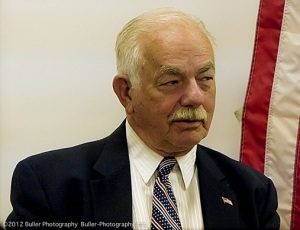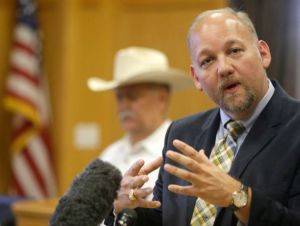[mpen-dayton4] FW: "Race in Waller County, Texas by abagond" & "President Obama on a special call" & "FW: Wesley Clark Calls for Internment Camps" & "Fukushima Daiichi Decommissioning: Follow The Money" and more
FYI. Best, Munsup
P.S. Please reply back to me with 'unsubscribe' on the subject line if you no longer want to receive
my e-Newsletters. The convenient link to unsubscribe is no longer available due to security reasons.
P.P.S. "He who dares not offend cannot be honest" - Thomas Paine
---------------------------------------------------------------------------------------------------------------------------------------
· FW: Health Care Justice March - August 1, 2015
· FW: OHIO COP INDICTED FOR SENSELESS MURDER OF UNARMED BLACK MAN
· FW: Race in Waller County, Texas by abagond
· FW: President Obama on a special call on Thursday, July 30
· FW: A void in the historical record of 9/11
· FW: more compassionate conservatism: find morally reprehensible seniors to cut social security pay outs
· FW: Celebrating 50 years of Medicare & Medicaid
· FW: Wesley Clark Calls for Internment Camps
· FW: Fukushima Daiichi Decommissioning: Follow The Money
· FW: BREAKING: GOP FAST-TRACKS bill to defund Planned Parenthood
· FW: "ALEC Admits School Vouchers Are for Kids in Suburbia"
--------------------------------------------------------------------------------------------------------------------------------------
From: SPAN Ohio
Subject: Health Care Justice March - August 1, 2015

SPAN Ohio has endorsed the Healthcare Justice March and some of us will be traveling to Washington, DC on Saturday, August 1, 2015 in order to participate. We want to make the opportunity available to all single payer supporters who might be interested.
We recognize that not all are able to travel or contribute, so following the Justice March flyer below we have listed opportunities here in Ohio to join together to make our voices heard: Medicare is as American as Apple PIE: Protect it, Improve it and Expand it to ALL.
..
Medicare's 50th Birthday Events in Ohio
Lakewood
Thursday, July 30, 2015
11:00 am to 2:00 pm - Lakewood Park at Belle and Lake Aves.
Games, food, music, followed by speeches
- Sarah Lowrey, aide to Senator Brown
- Senator Mike Skindell, primary sponsor of SB 137, Ohio's universal health care bill
- Marguerite Harkness, Save Lakewood Hospital
- Debbie Silverstein, State Director SPAN Ohio
March to Lakewood Hospital
Columbus
Thursday, July 30, 2015
10:30 a.m. press conference in Ladies Gallery of the Statehouse followed by a march to Senator Rob Portman's office. For the march, gather on the public walkway on State Street by the Ohio Theater.
Toledo
Thursday, July 30, 2015
5:30 PM at the UT Community Care Clinic
2150 South Byrne, Toledo, OH 43614. Located at South Byrne and Heatherdowns, Toledo
This is a combined celebration of Medicare's 50th birthday on the theme of "As American as Apple PIE," Protect, Improve and Expand Medicare. The Community Care Clinic provides a meal and free medical services to uninsured in the Toledo area. The location and time chosen emphasizes the significant need to insure everyone.
From: Norman Edwards [mailto:normankedwards@gmail.com]
Subject: OHIO COP INDICTED FOR SENSELESS MURDER OF UNARMED BLACK MAN
Ohio Cop Indicted on Murder Charge in Traffic-Stop Shooting
CINCINNATI — Jul 29, 2015, 5:04 PM ET
By LISA CORNWELL Associated Press
NEXT VIDEO Police Officer Indicted For Murder For Fatal Cincinnati Traffic Stop
A University of Cincinnati officer who shot a motorist during a traffic stop over a missing front license plate was indicted Wednesday on a murder charge, with a prosecutor saying the officer "purposely killed him" and "should never have been a police officer."
Hamilton County Prosecutor Joe Deters announced the grand jury indictment at a news conference to discuss developments in the investigation into the July 19 shooting of 43-year-old motorist Samuel DuBose by Officer Ray Tensing.
Authorities have said Tensing spotted a car driven by DuBose and missing the front license plate, which is required by Ohio law. They say Tensing stopped the car and a struggle ensued after DuBose refused to provide a driver's license and get out of the car.
Tensing, 25, has said he was dragged by the car and forced to shoot at DuBose. He fired once, striking DuBose in the head.
But Deters dismissed Tensing's claim that he was dragged by the car and suggested that he shouldn't have pulled DuBose over to begin with.
"He fell backward after he shot (DuBose) in the head," Deters said, adding that it was a "chicken crap" traffic stop.
On footage released from the body-camera video Wednesday, the officer could be heard asking for DuBose's driver's license several times with DuBose at one point saying he had one. Later, DuBose said, "But I don't think I have it on me."
Tensing asks DuBose to unbuckle his seat belt. About that time Tensing pulls on the door handle, and DuBose puts his hand on the door to keep it closed. Then the video becomes shaky, but a gunshot can be heard and DuBose appears to be slumped in the seat before the car rolls away, coming to stop at a nearby corner.
The University of Cincinnati said it fired Tensing after his indictment. Tensing turned himself in Wednesday afternoon at the Hamilton County Justice Center and was processed on charges of murder and voluntary manslaughter.
Tensing's attorney, Stewart Mathews, didn't return phone messages seeking comment after the indictment announcement.
Mathews said earlier Wednesday that he thought an indictment was likely "given the political climate" and comments made by city officials. But Mathews said given the evidence he's seen, he doesn't believe there should be an indictment.
DuBose's death comes amid months of national scrutiny of police dealings with African-Americans, especially those killed by officers. DuBose was black. Tensing is white. Authorities haven't indicated whether race was a part of the investigation.
Body-camera video of the shooting was also released Wednesday. DuBose's family had been pressing for its release, and news organizations including The Associated Press had sued Deters to get it released under Ohio open records law, but Deters released it before any ruling had been made.
Deters called the shooting "senseless" and "asinine."
"He purposely killed him," Deters said. "He should never have been a police officer."
The prosecutor also said he thought it was time to reconsider the UC police department's role.
"I don't think a university should be in the policing business," Deters said.
A message for comment was left Wednesday with the police department. The university said earlier this week it plans an independent review of its police department's policies.
The UC officer made the traffic stop near the university's main campus, and UC police have said the intersection was within the campus police's jurisdiction.
From: khalfani718
Subject: Race in Waller County, Texas by abagond
Race in Waller County, Texas
Tue 28 Jul 2015 by abagond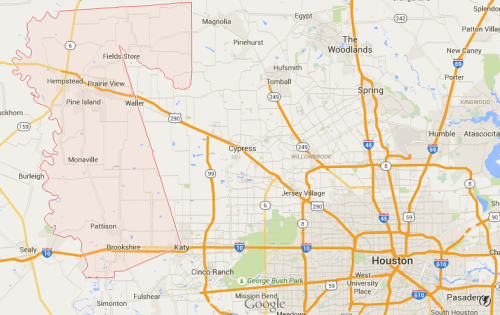
Waller County in pink, shown in relation to Houston and its suburbs. (From Google Maps, 2015.)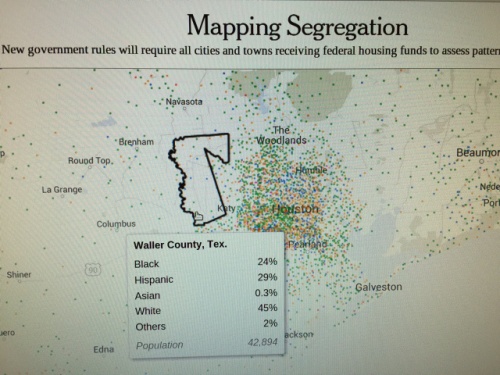
Waller County demographics (Photo: Will Opines).
Waller County, Texas, which lies along the Brazos River, about an hour north-west of Houston, is a place of small towns, cotton fields and a Black university, Prairie View A&M University, its economic anchor (pictured below). In 2010, the county was 24% Black (mostly university students), 29% Hispanic and 45% White.
Prairie View A&M University.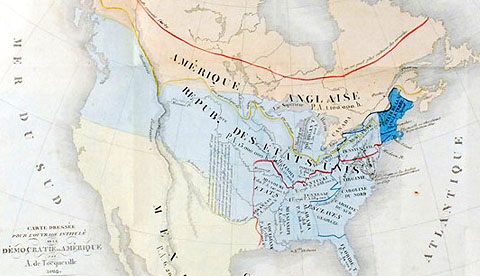
Tocqueville's map of North America, 1835. The US is in blue, Mexico in white.
In 1829, slavery was outlawed in Texas, then part of Mexico. Blacks fled there from the US.
In 1836, Whites took Texas from Mexico. By 1845, some 200 Whites in Waller owned over 1,000 Black slaves.
In 1865, after the Civil War, the US Army arrived in Texas on Juneteenth to free the slaves. In 1868, there was a race riot in Hempstead, the county seat.
In 1876, what would become Prairie View A&M was founded to educate Blacks, built on an old cotton plantation. In 1880, the county was mostly Black – and could vote!
In 1877, the US Army pulled out.
From 1877 to 1950, there were 15 lynchings, the third worst county in Texas. The (largely Black) Republican vote dropped by half from 1896 to 1900.
In 1903, "white primaries" in effect shut out Blacks from politics.
In the 1960s, students boycotted Hempstead businesses to force them to integrate. After Selma, Blacks could vote again.
In 1971, the voting age in the US dropped to 18. Because of the university, that greatly increased the Black vote. The county blocked students from voting unless they or their families owned property in the county. The courts overturned that in 1979.
In 2004, the county tried again: Oliver Kitzman, the district attorney, threatened to prosecute any out-of-county student who tried to vote, Supreme Court rulings be damned. Students forced him out, but the county still found ways to keep them from voting – until 2008, when a federal judge put the county under Department of Justice (DOJ) oversight.
In 2007, Glenn Smith, the police chief of Hempstead, was suspended without pay for two weeks and put on probation for six months for his "humiliation and mistreatment of young African American males." In 2008, after searching a young Black man's underwear in public, he was fired. He ran for higher office, county sheriff, and won. By a landslide.
In 2014, Elton Mathis, the district attorney, was accused of texting, "My hounds ain't even started yet dumb ass," to Rev. Walter Pendleton. Pendleton had asked for information on prosecution rates by ethnicity in the county, saying that Mathis practised "selective prosecution". Mathis: "You are too stupid to know what that word means."
Also in 2014, Waller County became one of 28 counties nationwide whose elections were monitored by the DOJ.
In 2015, Herschel Smith, a Black police officer and elected constable, was held by police for 45 minutes – while in uniform.
On July 10th, state trooper Brian Encinia, patrolling the road in front of the university, tailed Sandra Bland (pictured) and then pulled her over for failing to signal a lane change. He arrested her, roughed her up and sent her to the county jail – run by Glenn Smith.
On July 13th, Sandra Bland was found dead in jail.
Glenn Smith is leading the investigation. Elton Mathis will take it to a grand jury.
– Abagond, 2015.
From: Jo, Jadzia, Mark, Manny, and the rest of the team MoveOn.org Civic Action
Subject: President Obama on a special call on Thursday, July 30
In Thursday evening, at 6 p.m. ET (5 p.m. CT/4 p.m. MT/3 p.m. PT), you're invited to a special conference call with President Obama to discuss the historic nuclear agreement with Iran.
This is a rare chance for MoveOn members to hear directly from the president. As we ramp up our important work defending diplomacy and preventing a new U.S. war in the Middle East, we really hope you can join.
We're excited to invite you and other MoveOn members to join a conference call with President Barack Obama and folks from around the country to discuss the P5+1 Nuclear Deal with Iran. The President will discuss the historic deal and its importance to the country and the international community.
The call will take place on Thursday, July 30th, 2015 at 6:00 p.m.
PLEASE USE THE FOLLOWING INFORMATION TO CALL IN: (866) 254-5934, passcode 365802
We recommend you call in as close to 6:00 PM as possible, since space is limited for this exciting opportunity.
Thank you,
John Bisognano
Office of Public Engagement
The White House
This agreement will prevent Iran from obtaining nuclear weapons, while showing the world that diplomacy is an alternative to war. And over the next 60 days, MoveOn members are making it a priority to defend this deal.
Thousands of activists from across the country are expected to be on the line. We hope you'll be there too, representing MoveOn.
From: Eric Kramer
Subject: A void in the historical record of 9/11
It apears that those troubling 28 pages may actually speak volumes....
http://www.newyorker.com/news/daily-comment/twenty-eight-pages -  E
E
From: Andrew Tierman
Subject: more compassionate conservatism: find morally reprehensible seniors to cut social security pay outs
From the Steelworkers:
Senate Republicans seek to cut off social security for seniors with felony arrest warrants.
See http://www.rawstory.com/2015/07/senate-bill-could-kick-200000-seniors-off-social-security-if-they-have-an-arrest-warrant/
From: Mona Mangat
Subject: Celebrating 50 years of Medicare & Medicaid
50th anniversary of Medicare and Medicaid
This week marks the 50th anniversary of Medicare and Medicaid.
We've come a long way since President Lyndon B. Johnson signed Medicare and Medicaid into law. Today, Medicare provides health coverage to more than 55 million Americans and Medicaid is a lifeline for nearly 70 million -- including one in three children.
These programs have helped to create a health care system that is better, smarter, and healthier. They, along with the Affordable Care Act, represent some of our greatest achievements as a Nation.
As a doctor who takes care of people on both Medicare and Medicaid, I know that these numbers are real people that Doctors for America members care for every day in every corner of the country. It is hard to imagine going back to a time when half of seniors had no health coverage. We will continue to fight to protect these vital programs and expand Medicaid in the remaining 19 states.
Join us. Take action below to celebrate 50 years of Medicare and Medicaid.
And visit our website for more information.


From: khalfani718
Subject: Wesley Clark Calls for Internment Camps
Wesley Clark Calls for Internment Camps
for "Radicalized" Americans
Retired general and former Democratic presidential candidate Wesley Clark on Friday called for World War II-style internment camps to be revived for "disloyal Americans." In an interview with MSNBC's Thomas Roberts in the wake of the mass shooting in Chatanooga, Tennessee, Clark said that during World War II, "if someone supported Nazi Germany at the expense of the United States, we didn't say that was freedom of speech, we put him in a camp, they were prisoners of war."
He called for a revival of internment camps to help combat Muslim extremism, saying, "If these people are radicalized and they don't support the United States and they are disloyal to the United States as a matter of principle, fine. It's their right and it's our right and obligation to segregate them from the normal community for the duration of the conflict."
The comments were shockingly out of character for Clark, who after serving as supreme allied commander of NATO made a name for himself in progressive political circles. In 2004, his campaign for the Democratic presidential nomination was highly critical of the Bush administration's excessive response to the 9/11 terror attacks. Since then, he has been a critic of policies that violate the Geneva Convention, saying in 2006 that policies such as torture violate "the very values that [we] espouse."
In a memoir written the following year, he also famously alleged that the White House under Bush had developed a massively imperialistic plan for the Middle East, which would see the administration attempt to "take out seven countries in five years," beginning with the invasions in Iraq and Afghanistan.
Earlier this year I spoke with Clark at the annual Lewis and Clark University Symposium on International Affairs in Portland, Oregon. The subject of our discussion was how to deal with the potential threat of foreign fighters returning from armed conflicts abroad. At the time, Clark spoke out strongly against "the politics of fear" and eroding democratic institutions and norms, while reiterating his criticism of the excesses committed by Bush-era neoconservatives under the banner of fighting terrorism.
But on Friday, he was advocating the revival of a policy widely considered to be among the most shameful chapters in American history: World War II domestic internment camps. Aside from the inherent problems in criminalizing people for their beliefs, Clark's proposal (which his MSNBC interlocutor did not challenge him on) also appears to be based on the concept of targeting people for government scrutiny who are not even "radicalized," but who the government decides may be subject to radicalization in the future. That radicalization itself is a highly amorphous and politically malleable concept only makes this proposal more troubling.
"We have got to identify the people who are most likely to be radicalized. We've got to cut this off at the beginning," Clark said. "I do think on a national policy level we need to look at what self-radicalization means because we are at war with this group of terrorists." And he added that "not only the United States but our allied nations like Britain, Germany and France are going to have to look at their domestic law procedures."
Despite an outcry about his comments on social media, Clark has not responded publicly. As of Monday morning, his latest tweet was from Friday, encouraging his followers to watch his interview.
CONTACT THE AUTHOR: Murtaza Hussain✉murtaza.hussain@theintercept.comt@mazmhussain
From: Sally Leong
Subject: FW: Fukushima Daiichi Decommissioning: Follow The Money
This is the direct source of the best information about Fukushima. Gunderson is a well-respected nuclear engineer and has been covering this story from day one. He also reviews the plants in the US with similar vulnerabilities.
------------- Begin forwarded message:

Are the meltdowns at Fukushima Daiichi over? The answer is no. In Fairewinds' latest video, Chief Engineer and nuclear expert Arnie Gundersen updates viewers on what's going on at the Japanese nuclear meltdown site, Fukushima Daiichi. As the Japanese government and utility owner Tokyo Electric Power Company push for the quick decommissioning and dismantling of this man-made disaster, the press and scientists need to ask, "Why is the Ukrainian government waiting at least 100 years to attempt to decommission Chernobyl, while the Japanese Government and TEPCO claim that Fukushima Daiichi will be decommissioned and dismantled during the next 30 years?"
Like so many big government + big business controversies, the answer has nothing to do with science, and everything to do with politics and money. To understand Fukushima Daiichi, you need to follow the money.

Downstream
By Arnie Gundersen, Chief Engineer
More than four years after the triple meltdown at Fukushima Daiichi, many radioactive isotopes created inside the reactors as nuclear waste, including cesium, strontium, and plutonium, continue to bleed into the Pacific Ocean. Even though the Pacific Ocean contains more than 700 million cubic kilometers of water, low concentrations of radioactivity have already migrated across the Pacific to the Vancouver and Alaskan coasts as Fukushima Daiichi slowly contaminates the largest body of water on Earth.
The Pacific Ocean is 30,000 times larger than all the Great Lakes combined, and the once pristine watershed of the Great Lakes is now home to 30 nuclear power reactors. Eighteen of these nuclear reactors have the unique Canadian CANDU design and are located in Ontario Province at Bruce (8), Pickering (6) and Darlington (4), while 12 are US designs located at nine site locations in Michigan, New York State, Ohio, and Wisconsin. In addition, several temporary nuclear waste storage sites on Lake Huron near the Bruce site are in imminent danger of becoming permanent nuclear waste dumps that will be abandoned underground within one mile of the Lake.
Imagine the 39-year-old Bruce station on Lake Huron or the 44-year-old Palisades plant in Michigan on Lake Michigan having a meltdown like Fukushima Daiichi did in March 2011. The concentration of radioactive waste in the water would be roughly 30,000 times higher in the Great Lakes than in the Pacific Ocean after the triple meltdown at Fukushima Daiichi. Think of the devastation that would occur as 40,000,000 people lose their water supply and the crops along these waterways are contaminated with nuclear waste for decades if not hundreds of years as the St. Lawrence River flows right past Montreal and Quebec City. What are the commercial ramifications for cities along the Great Lakes or the St. Lawrence River when ocean freighters choose to no longer travel there for fear of contaminating the vessels?
Is a meltdown possible at one of the 30 reactors upstream from Montreal and Quebec City? Unfortunately, the answer is yes. Counting Three Mile Island, Chernobyl, and the three meltdowns at Fukushima Daiichi, there have been five meltdowns during the last 35-years. Three entirely different reactor designs in three different countries on three different continents have melted down spewing nuclear waste materials to many other areas. History shows that there will likely be a nuclear meltdown about once every seven years.
Where will the next meltdown be? There is no crystal ball with that answer, but engineers do know that the older a nuclear plant becomes, the more likely it will break. So could that meltdown be in older plants with the unique Canadian CANDU design at Bruce, Pickering or Darlington, in old embrittled plants like Palisades on Lake Michigan, or in any of the other US lakeside nuclear plants that are approaching 40-years old?

Review by Maggie Gundersen, President
Japan's Tipping Point: Crucial Choices in the Post-Fukushima World is a little paperback published November 1, 2011 by Vermont author Mark Pendergrast. Japan was at a crucial tipping point in its energy paradigm when Mark first wrote this book after the March 2011 triple meltdown at Fukushima Daiichi. Currently, Japan imports all of its fossil fuel and can no longer rely upon nuclear power, following the massive Fukushima Daiichi nuclear power tragedy.
Prior to Japan's Fukushima Daiichi nuclear power tragedy, Mark was awarded an Abe Fellowship for Journalists to visit five out of 13 so-called Eco-Model Cities, and shortly after the nuclear disaster, he traveled to "Japan to investigate Japan's renewable energy, Eco-Model Cities, food policy, recycling, and energy conservation, expecting to find innovative, cutting edge programs."
"I figured that because the Japanese import virtually all of their fossil fuel and are technologically sophisticated, that they must be doing innovative things with renewable energy," Mark has said.
Mark says he discovered that he was naive. Even though "the Japanese boast of their eco-services for eco-products in eco-cities… they rely primarily on imported fossil fuel …live in energy-wasteful homes, and import 60% of their food."
Like Mark Pendergrast, we at Fairewinds Energy Education had hoped that the massive tragedy of a triple meltdown at Fukushima Daiichi would become the Tipping Point for Japan. Arnie and I envisioned that by now the technological and entrepreneurial Japanese would lead the world in the innovative use of Small Modular Renewables, wave production technology, and larger innovative solar and wind installations. Instead, Germany, under the leadership of the physicist and once pro-nuclear Chancellor Angela Merkel, has taken world leadership in renewable energy and therefore has the strongest economy in Europe. Look at this week's news clips to see that even oil rich Saudi Arabia is grabbing renewable energy with both hands in an effort to maintain a rich energy portfolio as world demand for oil, gas, coal, and nuclear continues to decline.
Watch Fairewinds Energy Education's video Fukushima Decommissioning: Follow The Money to see how politics and money continue to push nuclear power and block Japan's economic growth and what could have been world dominance in renewable energy. Then read Mark's book Japan's Tipping Point: Crucial Choices in the Post-Fukushima World to further understand what futures are still possible for Japan.

Fairewinds in the News:
The Columbia Generating Station, a nuclear power facility in Washington, was shutdown on May 9th for refueling that was scheduled to take forty two days. Fifty days later, Columbia is only partially online, functioning at 60% of full operating capacity. Nuclear outages like this are planned to the hour, it is unusual to take an additional ten days then operate on only 60%. Nuclear plants are designed to be either shutdown or working at 100% capacity, not partial operation. In an interview with KBOO radio, Arnie Gundersen of Fairewinds Energy Education gives his expert analysis of what might be going on as the public is kept in the dark by both Columbia's owner Energy Northwest and the Nuclear Regulatory Commission.

Nuclear News:
Mycle Schneider's annual World Nuclear Industry Status Report 2015 is out! Last week, Fairewinds released Mycle Schneider's presentation to the World Uranium Symposium on the high cost of nuclear and the eclipse of economically viable renewable energy alternatives.
Schneider's latest nuclear industry report shows solar, wind and other forms of renewable energy besides hydro-electric dams now supply more electricity than nuclear does in Japan, China, India and five other major economies accounting for about half the world's population. Rising costs in construction, maintenance, and substantial building delays accompanied by increasing public opposition to its high risk of radioactive contamination has hurt the nuclear industry. While renewable energy sources are experiencing incredible price drops for consumers as they have become increasingly efficient, better managed, and now storable. "The impressively resilient hopes that many people still have of a global nuclear renaissance are being trumped by a real-time revolution in efficiency‐plus‐renewables‐plus‐storage, delivering more and more solutions on the ground every year," Jonathon Porritt, co-founder and trustee of the Forum for the Future, wrote in a foreword to the report.
Saudi Arabia, the world's second largest oil producer, is going solar. Currently the world's sixth-largest consumer of oil, Saudis burn a quarter of the oil they produce and their domestic consumption has been rising at an alarming 7 percent a year. According to The Atlantic, Saudi Arabia "isn't concerned about global warming; the last thing they want is an end to the fossil-fuel era. Quite the contrary: they see investing in solar energy as a way to remain a global oil power." As Saudi Arabia turns to solar power to save money, the country admits that solar is the more economic choice. The government has plans to build a commercial-scale solar-panel factory, and another factory is about to begin producing large quantities of polysilicon, a material used to make solar cells. Next year, Saudi Arabia's state owned electricity giants Saudi Aramco, the world's biggest oil company, and the Saudi Electricity Company have scheduled to begin 10 solar projects around the country.
Areva, the notorious French nuclear giant, has revealed that it has known since 2006 of the faulty steel vessel used in its European Pressurized Reactors (EPRs). The steel surrounding the top and bottom of Areva's EPRs contain excessive carbon that can cause disastrous cracks in the reactor vessel that cannot be replaced once the reactor is in operation. Until now, Areva maintained it had no knowledge of this tremendous flaw when it sold its $9 Billion EPR model to Finland, China, and Great Britain.
Japan currently has 17,000 metric tons of radioactive waste and nowhere to put it. "It's part of the price of nuclear energy," Allison Macfarlane, former Chairwoman of the U.S. Nuclear Regulatory Commission, said in Tokyo in an interview about atomic waste.
Due to the magnitude of the Fukushima Daiichi nuclear catastrophe, all of Japan's 43 operational nuclear reactors have remained offline. Safety checks of each nuclear power plant have resulted in the permanent shutdown of five reactors, while politicians and nuclear industry lobbyists and their bankers argue about restarting this technology.
It would be a "failure in our ethical responsibility to future generations" to restart reactors without a clear plan for waste storage The Science Council of Japan said in April. Japan remains extremely challenged in its attempt to clean up the site of the 2011 Fukushima Daiichi nuclear meltdowns because the technology to do so has not yet been invented and the cost is already estimated to reach half a trillion dollars.
As Japan's nuclear industry continues to push for restart the idled plants, Japan's Nuclear Waste Management Organization (NUMO) decided to impose nuclear waste storage in select regions of the country as a permanent storage solution rather than the organization's original proposal to give districts the opportunity to volunteer storage. No regions in Japan had volunteered to accept the burden of nuclear waste abandonment, and at least 70% of the Japanese people remain opposed to restarting the shutdown nukes.
Attorney Peter Bradford, former member of the Nuclear Regulatory Commission, and Chair of both the Maine and New York utility regulatory commissions, pointedly criticized the promotion of nuclear power in the Maine Legislature this session by Gov. Paul LePage and Sen. Eric Brakey.
In a special release from the Bangor Daily News, Bradford questions Sen. Brakey's push for a thorium reactor to be built in Maine using a uranium isotope different from those that fuel nearly all of today's power reactors.Bradford is criticized Gov. LePage's attempt to exempt "small modular reactors" from Maine's required public referendum process for all nuclear power plants.
"What on earth is going on here?", Bradford asks since both nuclear reactors proposed by Brakey and LePage have never been built or operated any where in the world, and no one knows their cost or if the technologies would even work.
With skyrocketing market price projections for electricity produced by nuclear reactors currently being constructed at customers' expense in South Carolina and Georgia, no private company will invest in a new reactor in Maine with New England's preexisting power market rules. Moreover, large public subsidies would be required to finance the construction of either a thorium reactor or a small modular reactor contradicting Gov. LePage's veto of much smaller subsidies for solar energy.
Maine has already built, operated, and shut down a nuclear power plant that now sits full of radioactive waste without a permanent resting place. The Legislature's solar energy subsidy would have added a surcharge amounting to less than one-tenth of a percent to Maine electric bills versus the high cost of expensive experimental nuclear technology. Expensive nuclear power boondoggles and no permanent technological solution for massive amounts of nuclear waste is why Fairewinds supports Small Modular Renewables.
"An earthquake will destroy a sizable portion of the coastal Northwest. The question is when," writes New Yorker contributor Kathryn Schulz in her latest article entitled "The Really Big One".
By examining the sequence of natural disasters that occurred in Japan on March 11, 2011, world-leading seismologists conclude that what happened along the Japanese coast was a "foreshock" or a preview of another earthquake still to come.
And where will this occur? Seismologists predict that the Cascadia subduction zone, a fault line north of the renowned San Andreas fault, is at most risk for the next big earthquake challenging humankind. The Cascadia subduction zone begins seven hundred miles off the coast of the Pacific Northwest near Cape Mendocino, California, continues along Oregon and Washington, and terminates around Vancouver Island, Canada. This subduction zone gets its name from the Cascade Range, a chain of volcanic mountains and connecting faults that follow the same course inland where the Columbia Generating Station resides with a BWR-5 reactor and Mark II containment structure, just like the one at Fukushima Daiichi.
Subduction zones indicate a portion of the earth where one tectonic plate is sliding over the other. These zones breed earthquakes and tsunamis. The result of an earthquake from the Cascadia subduction zone would directly effect the cities Seattle, Tacoma, Portland, Eugene, Salem, Olympia, and some seven million people.
"Our operating assumption is that everything west of Interstate 5 will be toast," said Kenneth Murphy, who directs FEMA's Region X, the division responsible for Oregon, Washington, Idaho, and Alaska. The devastation will be unlike any other natural disaster in history with FEMA estimating nearly thirteen thousand people dead, twenty-seven thousand injured, and the need to provide shelter for a million displaced people, plus food and water for another two and a half million.
Fairewinds Energy Education · 70 S Winooski Ave, 289, Burlington, VT 05401, United States
This email was sent to threefawnmeadows@me.com. To stop receiving emails, click here.
You can also keep up with Fairewinds Energy Education on Twitter or Facebook.
From: Alexandra Hart, People For the American Way
Subject: BREAKING: GOP FAST-TRACKS bill to defund Planned Parenthood
Mitch McConnell just fast-tracked a bill to defund Planned Parenthood! A vote could come as soon as Monday!1
This means we need to kick our campaign to stand with Planned Parenthood into high gear to defeat this bill.
Will you rush a generous donation of any amount you can to PFAW right now to help us defeat this attack on Planned Parenthood and America's women>>
(And all gifts are still being MATCHED, dollar-for-dollar, through July 31, so this is a chance to DOUBLE your impact against the Right's attacks on women!)
This all started when a radical anti-choice group with ties to abortion clinic bombers released highly edited "sting" videos that dishonestly smear Planned Parenthood.
Now another right-wing group claims to have HACKED Planned Parenthood's records, putting employees and patients at risk.
Planned Parenthood provides vital health services to millions of women (and men) every year, and is one of the only providers of health care to many low income women. And they're under attack from all angles.
It's not just an attack on Planned Parenthood. It's an attack on women.
Now, the legislative effort to defund Planned Parenthood -- led by Sens. Rand Paul, Ted Cruz, and freshman Tea Party radical Joni Ernst of Iowa -- is on the fast track for passage if we don't stop it!
Please rush a MATCHED donation of whatever you can afford to help PFAW defeat this attack, even if you've already given>>
Tens of thousands of PFAW members have already spoken out to tell Congress to lay off Planned Parenthood. (If you're among them, THANK YOU.)
We're also organizing activist responses in the states, mobilizing faith leaders to speak out in Planned Parenthood's defense … using videos to expose the anti-choice extremism of the groups behind the sting campaign … and more.
But we need your help.
Please make a rush donation to our campaign to defeat these witch hunt attacks on Planned Parenthood now -- your gift will be MATCHED>>
Thank you for all of your amazing support. Together, we'll win this fight!
Senate GOP Fast-Tracks Bill To Defund Planned Parenthood
http://www.huffingtonpost.com/entry/senate-gop-fast-tracks-bill-to-defund-planned-parenthood_55b8274ae4b0074ba5a6bc43?kpvz33di
From: khalfani718
Subject: "ALEC Admits School Vouchers Are for Kids in Suburbia"
http://www.truth-out.org/news/item/32026-alec-admits-school-vouchers-are-for-kids-in-suburbia
ALEC Admits School Vouchers Are for Kids in Suburbia
Thursday, 23 July 2015 00:00 
(Photo: Suburbs via Shutterstock)
Truthout combats corporate power by bringing you trustworthy, independent news.
Join our mission by making a donation now - whatever you can spare will be matched dollar-for-dollar!
School vouchers were never about helping poor, at-risk or minority students. But selling them as social mobility tickets was a useful fiction that for some twenty-five years helped rightwing ideologues and corporate backers gain bipartisan support for an ideological scheme designed to privatize public schools.
But the times they are a-changin'. Wisconsin is well on its way towards limitless voucher schools, and last month, Nevada signed into law a universal "education savings account" allowing parents to send their kids to private or religious schools, or even to homeschool them - all on the taxpayers' dime. On the federal level, a proposed amendment to the Elementary and Secondary Education Act that would have created a multi-billion-dollar-a-year voucher program was only narrowly defeated in the US Senate.
The American Federation for Children (AFC), chaired by Amway billionaire Betsy DeVos, estimates that vouchers and voucher-like tax-credit schemes currently divert $1.5 billion of public money to private schools annually. But that is not enough. By expanding "pro-school choice legislative majorities" in state houses across the country the organization hopes that $5 billion a year will be siphoned out of public schools by 2020 and applied to for-profit and religious schools.
With vouchers gaining momentum nationwide, the American Legislative Exchange Council (ALEC), which is meeting in San Diego today, has decided to drop the pretense that vouchers have anything to do with social and racial equity, and is now pushing vouchers for the middle class - a project which, if pursued enough in numbers, will progressively erode the public school system and increase the segregation of students based on race and economic standing.
ALEC Comes Clean, Vouchers Are for the Middle Class
The agenda for this week's ALEC meeting includes a presentation entitled: "Problems in Suburbia: Why Middle-Class Students Need School Choice, Digital Learning and Better Options."
Perhaps more importantly, ALEC's revisions to three of its "model" voucher bills make clear that it is changing focus from underserved inner-city schools to middle-class suburbia. The talking points at the end of the bills state:
· "Legislators … should keep in mind the financial burden many middle-class families face in paying for private schools."
· "The authors believe that all children from low- and middle-income families should receive public support for their education regardless of whether they are attending a public or private school."
· "The authors do not adjust the amount granted to an ESA [Education Savings Account] student based upon the student's income because states do not adjust the public investment for a student attending a traditional public school or a charter based upon their household income."
As if to further nail down the point that school vouchers are not about equity, ALEC also advises legislators against including language "banning discrimination in hiring." But if they choose to do so, they should "take care not to interfere with the ability of religious institutions to hire individuals who share their religious beliefs."
"Abolishing the Public School System"
ALEC is not the only organization coming clean on vouchers.
At the American Federation for Children's National Policy Summit held in New Orleans, lobbyist Scott Jensen - who, before being banned from Wisconsin politics for violating the public trust served as chief of staff to governor Tommy Thompson, and was a prime mover behind the first voucher program in the nation - admitted that vouchers were really all about "pursuing Milton Friedman's free-market vision" even though the ideological agenda was nowadays sugarcoated with "a much more compelling message ... of social justice."
So what exactly was the brave new world Milton Friedman envisioned when he first floated the idea of school vouchers? While lecturing rightwing state lawmakers at a 2006 ALEC meeting, Friedman jumped at the opportunity to explain what his vision was all about. It had nothing whatsoever to do with helping "indigent" children; no, he explained to thunderous applause, vouchers were all about "abolishing the public school system."
Here is an excerpt from Friedman's ALEC speech:
If I were to ask everyone here, what would be your idea of the right way to conduct, to have an educational system constructed, you would say the ideal would be to have parents control and pay for their school's education, just as they pay for their food, their clothing and their housing. That, of course, would leave some indigent and problems of charity. Those should be handled as charity problems, not educational problems. The reason we cannot do that is because taxes are used to pay not for education, but for schools, for teachers.
How do we get from where we are to where we want to be - to a system in which parents control the education of their children? Of course, the ideal way would be to abolish the public school system and eliminate all the taxes that pay for it. Then parents would have enough money to pay for private schools, but you're not gonna to do that. So you have to ask, what are politically feasible ways of solving the problem. The answer, in my opinion, is choice, that you have to change the way government money is directed. Instead of it being used to finance schools and buildings, you should decide how much money you are willing to spend on each child and give that money, provide that money in the form of a voucher to the parents of the children so the parents can choose a school that they regard as best for their child.
Ditching the Marketing Plan
By shifting the focus from poor, minority children to the predominantly white middle class, ALEC has come full circle. Vouchers were first proposed in the 1950s as a way for white families to get around the desegregation resulting from the Brown vs. Board of Education Supreme Court Decision. ALEC first pitched vouchers to legislators in 1984 as a way to "introduce normal market forces" into education and to "dismantle the control and power of" teachers' unions. While there was a narrative of parent "empowerment" at that time, there was not even a passing mention of children - let alone minority children.
But when William Bennett joined Ronald Reagan's cabinet in 1985, vouchers soon gained a unique selling point. In the words of The Black Commentator:
Former Reagan Education Secretary William Bennett understood what was missing from the voucher political chemistry: minorities. If visible elements of the Black and Latino community could be ensnared in what was then a lily-white scheme, then the Right's dream of a universal vouchers system to subsidize general privatization of education, might become a practical political project. More urgently, Bennett and other rightwing strategists saw that vouchers had the potential to drive a wedge between Blacks and teachers unions, cracking the Democratic Party coalition. In 1988, Bennett urged the Catholic Church to "seek out the poor, the disadvantaged…and take them in, educate them, and then ask society for fair recompense for your efforts"–vouchers. The game was on.
Conservative think tanks and advocacy groups across the nation soon launched massive whitewashing campaigns; they started churning out policy reports and books purporting to show how school vouchers would actually benefit minority students. Examples include: We Can Rescue Our Children: The Cure for Chicago's Public School Crisis (Heartland Institute, 1988) and Liberating Schools: Education in the Inner City (Cato Institute, 1990).
By proposing schemes with vouchers weighted to boost racial diversity, or restricted to children from low-income families, the organizations pushing vouchers were able to kill two birds with one stone. They made them acceptable by obscuring the segregationist history, and, crucially, they could now cast themselves as the "new" civil rights movement.
In state after state, politicians were in on the trick. They would sign limited voucher programs into law as "civil rights" measures only to gradually expand the programs to higher-income white families. The Milwaukee program - the first in the country - was originally restricted to families learning less than 175 percent of the federal poverty level. But under Gov. Scott Walker, the income ceiling was recently upped to 300 percent. A married couple with two children can currently earn $78,647, which is far more than the median US family income of $52,250, and still send them off to private schools at the public's expense. Most students receiving vouchers last year were already attending private schools - meaning vouchers were being used a taxpayer subsidy for private education rather than as a way for students to escape underperforming public schools. Walker's newest voucher expansion in the state budget could suck some $600-800 million out of public schools over 10 years.
"They have high-jacked the program," Annette "Polly" Williams, an African-American lawmaker who co-sponsored the original bill, told the Milwaukee Journal Sentinel.
This is a pattern across the country. The voucher-like corporate tax credit program in Georgia was originally billed as a way of helping African-American and Latino families, but most scholarships have been awarded "white students from upper income families," the Southern Education Foundation wrote in a scathing report. In 2013, Governor Mike Pence of Indiana raised the income requirements of the voucher program in the Hoosier State, and last year, Florida's Republican governor Rick Scott lifted the income bar for the state voucher program, allowing a family of four making up to $62,010 a year to participate - $20,000 higher than the previous ceiling.
With upped income ceilings in multiple states - not to mention the universal "Education Savings Account" system signed into law in Nevada last month - ALEC seems poised to ditch the civil rights "marketing plan," (as the rightwing Heartland Institute aptly put it in a 1991 paper) and get back to basics: school vouchers are for privatizing public education.
ALEC makes this abundantly clear when it recommends in its talking points that legislators not adjust the amount granted based on family income. The upshot of this is that vouchers will be a welcome bonus for well-off families whereas poor families may not be able to afford private school tuition even with the extra money.
This, in turn, will lead to increased segregation "based on race, socio-economic status, disability, English language proficience," as public school watchdog Educate Nevada Now warned when Gov. Sandoval signed the universal ESAs into law in June - a prospect that does not seem to faze ALEC legislators who are set to renew and refresh these policies in San Diego today.
This piece was reprinted by Truthout with permission or license. It may not be reproduced in any form without permission or license from the source.
End of MPEN e-Newsletter
